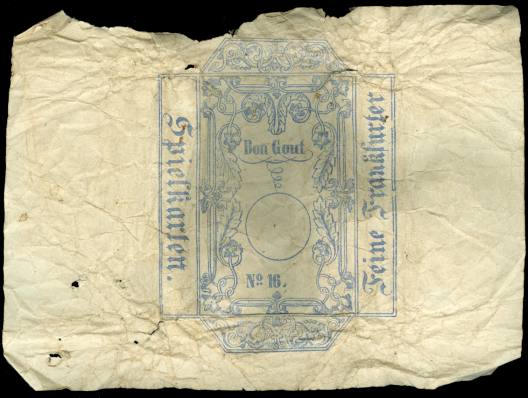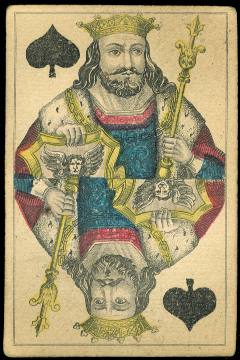

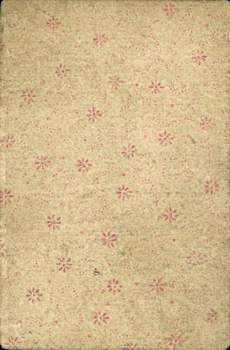
January 2011
January started with a white landscape around us. Fortunately that changed after the first week and we were able to visit the general collectors fair in Utrecht, which started on the 14th. We had decided not to take a stall there this time, but just walk around and see what goodies the collectors had for sale. Nothing really spectacular turned up, but we came home with a bunch of single jokers and a few decks anyway. The next weekend there was the usual flea market, but this time it brought us no real finds either.
There has been a relapse in Miriam's condition and that means that she's home again on prednisone and Joop is back on double shifts in the household. But being at home has its advantages. There's more time to surf the internet and its online auction sites. Ebay brought us a few good decks again, but these were -like last month- not actual new decks, but of better quality than the ones already in our collection: we now have an original box with the Art Ball deck (US, 1971) and the Philibert "Musketeers" deck (France, c1960) is better cut. But there were also some attractive modern decks: one from Ethiopia with Ethiopian indices and numbers and the third official Grateful Death deck.
Ebay has auction sites around the world. All the main countries have their own version and there's a Dutch one too, but there's not much action there. Before the Ebay site started in the Netherlands there was already a Dutch auction site called Marktplaats (market place). There was more action on that site and the start of a Dutch Ebay didn't change that. So Ebay bought the competition, but left their rules and regulations as they were. Marktplaats is almost typical Dutch, a sort of Wild West place. There's no feedback system, no need to bid online. If there's a telephone number, you just call up with a bid, negotiate a bit and settle the buy offline. Most of the time the auction isn't removed after that, so it's possible that you make an online bid while the item is already gone. It took us a while to figure that out and we missed some nice goodies that way. But it's also a free auction site with no entry or exit fees for private sellers. Hence its popularity among the Dutch.
By now you must have guessed where this Deck of the Month came from. It was advertised as "Speelkaartendoos" (playing card box) and indeed came with a large box holding 4 small boxes and this deck. Unfortunately the deck is incomplete, in reasonably soiled condition and has a curve, but........... it was made by a hardly known German playing card maker, comes with a rarely seen set of scenic aces and is probably at least 130 years old. Reasons enough to buy the deck and share it with you here.



Unfortunately the Jack of Spades is one of the missing cards. The deck consists of 38 cards, but the pips which are present range from 2 through 7 in each suit, except the Clubs, where the 2 is also missing. So it could have been a complete deck of 52 cards which has been transformed by a previous owner into an Hombre deck by throwing out the 8, 9 and 10's of each suit. But it could also originally have been published as an Hombre deck.
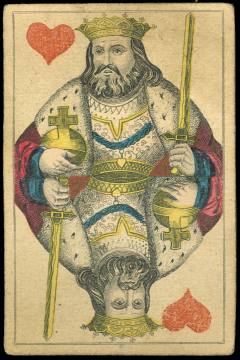
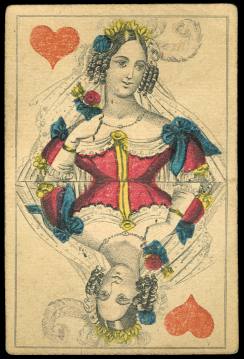

As said, the deck comes with a rarely seen set of aces. They show scenes from Washington, Baltimore, New York, Vera Cruz and Mexico.
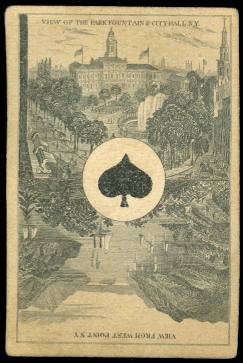 |
Most of the scenes are those one may expect: famous buildings, views or streets. But there's one scene that is a bit odd in this set: Chatham Square in New York. It's depicted on the Ace of Diamonds, together with a view of Broadway. According to Wikipedia Chatham Square was used as an open air market place for goods and livestock until the 1820's. In the mid 19th century it was known for its tattoo parlors, flophouses and saloons. A rather poor neighborhood in the 1870's and one may wonder why this square was chosen for this set. |
|
 |
|
The pattern on the courts vaguely resembles the Frankfurt pattern, but there are numerous differences. E.g. the King of Spades holds a shield and the King of Clubs holds a harp, which could be based on the Parisian pattern. If there is an official IPCS classification of this pattern, we couldn't find it, so anyone with some information about this pattern is welcome to send it in and we'll add it here on the page.
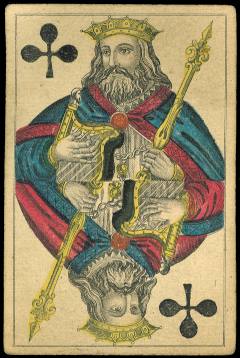

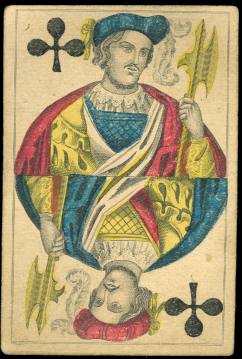
|
The maker's logo on Queen of Diamonds |
The IM stands for Johann Müller. According to German collectors this cardmaker was the successor of J. A. Steinberger in Frankfurt. Apparently he has continued his business in Offenbach later on. Johann Müller was active as a manufacturer of playing cards in the 1870's. From
Sigmar
Radau: Die Spielkartenfabrik "Lennhoff & Heuser", Frankfurt
a./Main. In: Das Blatt, Schriftenreihe der Deutschen
Spielkartengesellschaft Bube Dame König, Nr.
10, Berlin 1994, S. 33, we learn that
in 1872 a Johannes Müller was mentioned in the address-book of Frankfurt as "Johannes
Müller, vormals Johann Anton Steinberger, Sandweg 21, Theissinger
Papeterie, Fabrik u. Handl[ung]
in Spielkarten, Eigentümer Johannes Müller, Ass.: Frz. Jos.
Niderreuter." |
 |
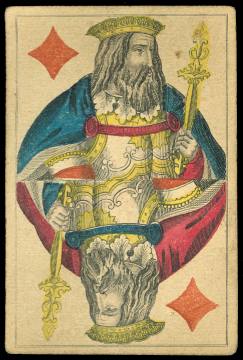
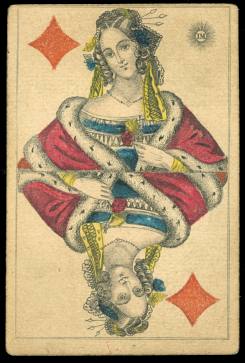
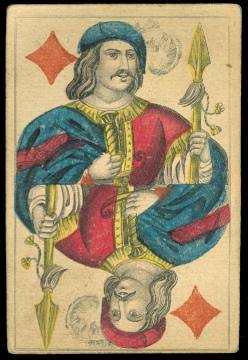
The deck came in this wrapper, but as the name of the maker is nowhere to be found, we can only assume that it is the original wrapper. And that brings the next dilemma. It doesn't mention that the wrapper contained an Hombre deck. As this is vital information for both buyer and seller, the nature of the deck is usually mentioned on wrappers and boxes. Instead it says "Bon Gout", "No. 16" and "Feine Frankfurter Spielkarten". So if this would be the original wrapper, then we must sadly conclude that it is most likely that the deck originally consisted of 52 cards. Still, we are very happy with this find and hope you'll enjoy it too.
